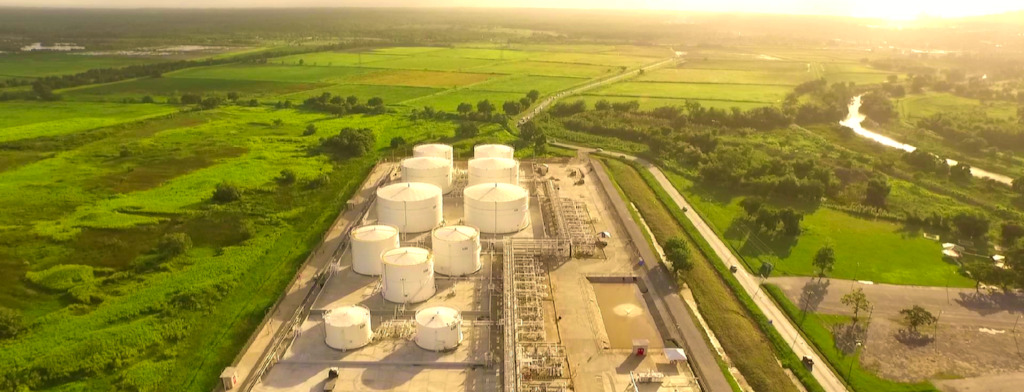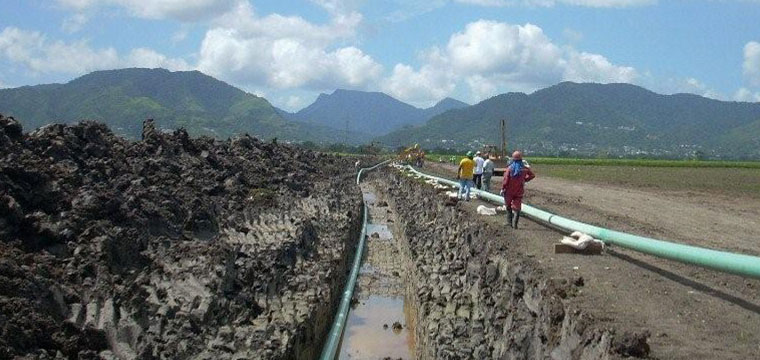
Liquid Fuels Pipeline
The Liquid Fuels Pipeline from Pointe‐a‐Pierre to Fredrick Settlement, Caroni.
More Under "Pipeline Projects"
North-Eastern Offshore Pipeline (NEO)
The North-Eastern Offshore Pipeline (Neo) off the east coast of Trinidad.
Visit Page »Tobago Pipeline
Tobago's first sub-sea natural gas pipeline from NGC.
Visit Page »Union Pipeline Project
About Our Union Pipeline Project at the Union Industrial Estate.
Visit Page »
Currently Reading "Liquid Fuels Pipeline"
NGC has worked in collaboration with two other state enterprises namely; Petroleum Company of Trinidad and Tobago Limited (PETROTRIN) and the Trinidad and Tobago National Petroleum Marketing Company Limited (NP) to project manage, design, construct and commission the Liquid Fuels Pipeline Project.
The Liquid Fuels Pipeline Project comprises three facilities: the Pointe-a-Pierre Facility, Caroni Terminal Facility and Piarco Receiving Terminal Facility. The Pointe-a-Pierre facility embodies a Storage Tank Farm, Cross Refinery Pipeline, Multi-Fuel product pipeline and associated Valve Stations. Fuels are introduced into the storage tanks and product is moved into the pipeline network. The main pipeline 8”ø(Multi-fuel) was designed to transport 1.6 million gallons or 42,000 barrels per day of refined distillates (Gasolines: Unleaded 95 and 92, Diesel and Jet A-1). It started at Petrotrin’s Pointe‐a‐Pierre West Area and ends at the Frederick Settlement, Caroni Terminal Facility a distance of approximately 42km. Another pipeline (8”ø) and approx. 12km in length was installed to transfer exclusively Jet A-1 to the Piarco Facility to serve the Piarco International Airport.
Four tanks were constructed at the P-a-P Facility with the capacity to store Unleaded 92- 30,000bbls; Unleaded 95- 24,000bbls; Diesel – 45,000bbls; Jet A-1 – 30,000bbls. At this location two Variable Frequency Drive pumps are used to transfer product to the Caroni Facility.
The Caroni facility contains 15 tanks: Unleaded 92 – Two; Unleaded 95 – Two; Diesel – Two ; Jet A-1 – Three; High Flash Slop – One; Low Flash Slop – One; Potable water – One; Fire water – One. From the fuel tanks, fuel will be pumped to the Loading Bay/Gantry which is made up of fifteen Loading Bays carrying a total of 28 Loading Arms. These arms are used to transfer the fuel to the Road Tank Wagons (RTW). Sixteen of these arms are for dispensing Gasolene, ten for Diesel, one for Jet A-1 and one for Slop. The fuels will be distributed to the various gas stations using the Road Tank Wagons.
The main control systems are the Pipeline Control System (PCS) which monitors the product movement between the three facilities and the Terminal Automation System (TAS) which governs the movement of fuel within the facility from the tanks to the Gantry.
There are several other systems which are integral to the operations of this facility. These are as follows:
- Tank Gauging System (TGS)
- Leak Detection System (LDS)
- Safety Instrumented System (SIS)
- Batch Management System (BMS)
- Fence Intrusion System (FIS)
- Metering Skids
- Fire Protection System
- Vapour Recovery Unit (VRU)
- Closed Circuit Television System (CCTV)

Although jet fuel will be taken directly to Piarco by pipeline, the loading arm at the Caroni Facility will be used to dispense jet fuel to operators of light aircraft and helicopters.
The storage capacity at the Caroni Facility is as follows:
- Unleaded 92 – 92,000 bbls
- Unleaded 95 – 64,000 bbls
- Diesel – 110,000 bbls
- Jet A-1 – 52,500 bbls
The capacity of the main interconnecting pipelines are as follows:
- Cross Refinery pipeline(2.4km) – 800 bbls
- Multi-Fuel Pipeline( 42km) – 9000 bbls
- Jet Fuel Pipeline( 12km) – 2300 bbls
The fuel will be sent through the pipeline in batches one after the other and the interfaces (Slop/Transmix) between different fuels in the pipeline, will be monitored electronically through highly sensitive instrumentation (Densitometer/Optical Analyzer) and diverted to storage (for eventual re-treatment) in a dedicated slop/transmix tank.
This system will make the transportation of liquid fuels safer, more reliable and more efficient. At the moment, most liquid fuels are transported by marine tanker from Petrotrin to the NP facility at Sea Lots in Port of Spain. The fuels pipeline will replace the tanker between Petrotrin and NP Sea Lots. It will also no longer be necessary for tank wagons to carry jet fuel on the roads.
Security of supply is a major consideration. In light of this, the Liquid Fuels Pipeline Project is intended to improve the security of supply and reduce the number of RTWs in operation and ultimately serving to decrease road congestion and carbon emissions.
What are the benefits of the Liquid Fuel Pipeline initiative?
- The facility will replace aged top loading fuel gantries at Pointe-a-Pierre and Sea Lots.
- Reduce the dependence on Ocean Tankers and Road Tank Wagons for delivery of products.
- Increased bunkering capacity at Pointe-a-Pierre, Caroni Terminal Facility and Piarco Receiving Terminal.
- Dedicated Multi-Fuel Product Pipeline for transportation of products from Pointe-a-Pierre to Caroni Terminal Facility.
- Dedicated JET-A1 Fuel Product Pipeline for transportation of product from Caroni Terminal Facility to Piarco Receiving Terminal.
- Enhanced security of fuel supply and availability to population of Trinidad and Tobago as well as for aviation industry.
- Eventual phasing out of marine product transportation and JET-A1 handling from Point-a-Pierre.